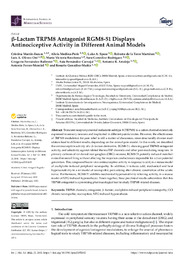Please use this identifier to cite or link to this item:
https://hdl.handle.net/11000/34395Full metadata record
| DC Field | Value | Language |
|---|---|---|
| dc.contributor.author | Martín Escura, Cristina | - |
| dc.contributor.author | Medina Peris, Alicia | - |
| dc.contributor.author | Spear, Luke | - |
| dc.contributor.author | de la Torre-Martinez, Roberto | - |
| dc.contributor.author | Olivos-Oré, Luis A. | - |
| dc.contributor.author | Barahona, M. Victoria | - |
| dc.contributor.author | González-Rodríguez, Sara | - |
| dc.contributor.author | Fernandez-Ballester, Gregorio | - |
| dc.contributor.author | Fernandez-Carvajal, Asia | - |
| dc.contributor.author | Artalejo, Antonio R. | - |
| dc.contributor.author | Ferrer-Montiel, Antonio | - |
| dc.contributor.author | GONZALEZ-MUÑIZ, ROSARIO | - |
| dc.contributor.other | Departamentos de la UMH::Bioquímica y Biología Molecular | es_ES |
| dc.date.accessioned | 2025-01-11T16:25:00Z | - |
| dc.date.available | 2025-01-11T16:25:00Z | - |
| dc.date.created | 2022 | - |
| dc.identifier.citation | International Journal of Molecular Sciences | es_ES |
| dc.identifier.issn | 1422-0067 | - |
| dc.identifier.issn | 1661-6596 | - |
| dc.identifier.uri | https://hdl.handle.net/11000/34395 | - |
| dc.description.abstract | Transient receptor potential melastatin subtype 8 (TRPM8) is a cation channel extensively expressed in sensory neurons and implicated in different painful states. However, the effectiveness of TRPM8 modulators for pain relief is still a matter of discussion, since structurally diverse mod ulators lead to different results, depending on the animal pain model. In this work, we described the antinociceptive activity of a β–lactam derivative, RGM8-51, showing good TRPM8 antagonist activity, and selectivity against related thermoTRP channels and other pain-mediating receptors. In primary cultures of rat dorsal root ganglion (DRG) neurons, RGM8-51 potently reduced menthol evoked neuronal firing without affecting the major ion conductances responsible for action potential generation. This compound has in vivo antinociceptive activity in response to cold, in a mouse model of oxaliplatin-induced peripheral neuropathy. In addition, it reduces cold, mechanical and heat hypersensitivity in a rat model of neuropathic pain arising after chronic constriction of the sciatic nerve. Furthermore, RGM8-51 exhibits mechanical hypersensitivity-relieving activity, in a mouse model of NTG-induced hyperesthesia. Taken together, these preclinical results substantiate that this TRPM8 antagonist is a promising pharmacological tool to study TRPM8-related diseases. | es_ES |
| dc.format | application/pdf | es_ES |
| dc.format.extent | 24 | es_ES |
| dc.language.iso | eng | es_ES |
| dc.publisher | MDPI | es_ES |
| dc.relation.ispartofseries | 23 | es_ES |
| dc.rights | info:eu-repo/semantics/openAccess | es_ES |
| dc.rights | Attribution-NonCommercial-NoDerivatives 4.0 Internacional | * |
| dc.rights.uri | http://creativecommons.org/licenses/by-nc-nd/4.0/ | * |
| dc.subject | TRPM8 channels | es_ES |
| dc.subject | antagonist | es_ES |
| dc.subject | β–lactam | es_ES |
| dc.subject | oxaliplatin-induced peripheral neuropathy | es_ES |
| dc.subject | CCI chronic neuropathic | es_ES |
| dc.subject | nociception | es_ES |
| dc.subject | NTG-induced hyperesthesia | es_ES |
| dc.subject.other | CDU::5 - Ciencias puras y naturales::57 - Biología::577 - Bioquímica. Biología molecular. Biofísica | es_ES |
| dc.title | β-Lactam TRPM8 Antagonist RGM8-51 Displays Antinociceptive Activity in Different Animal Models | es_ES |
| dc.type | info:eu-repo/semantics/article | es_ES |
| dc.relation.publisherversion | https://doi.org/10.3390/ijms23052692 | es_ES |

View/Open:
8-International Journal of Molecular Sciences 2022.pdf
672,99 kB
Adobe PDF
Share:
.png)
